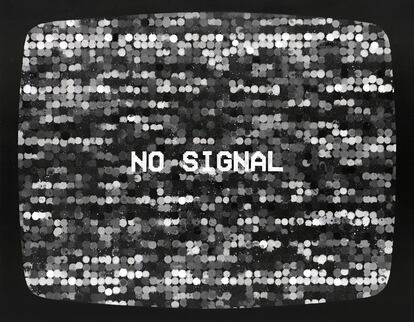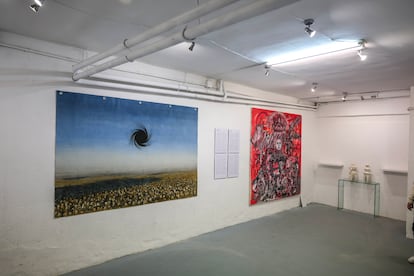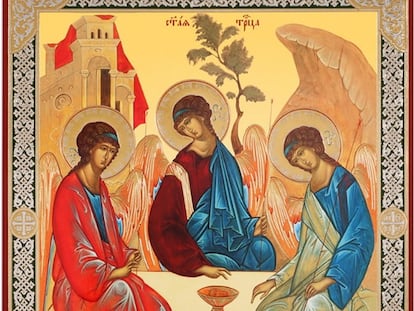In a new art exhibition, the Kremlin’s brainwashing methods are revealed
Eight Russian creators in exile have participated in a collective exhibition, which highlights the invasion of Ukraine and the Putin administration’s indoctrinating propaganda

When street artist Philippenzo, 39, found a wanted notice from the police when he arrived home, he knew that his life was about to change. Hours earlier — amidst the patriotic celebration of Russia Day, on June 12, 2023 — he painted a mural under Moscow’s Elektrozavodskiy Bridge, with the word izrossilovaniye… a play on letters that forms the sentence “Russia rapes you.”
The next morning, Philippenzo turned off his cell phone and dressed up in glasses and a cap. He then escaped on a flight to Georgia. “The work alludes to Putin’s abuses against his own citizens and against Ukraine,” he explains to EL PAÍS.
His is just one of the dozens of stories of persecution and repression suffered by Russian artists who dare to create works critical of the invasion of Ukraine, or works that question the Russian government in general. Through an exhibition at La Zona Gallery in Madrid, Spain, titled Lavado de cerebro (or “Brainwashing” in English), several creators are exhibiting their art, which dissents from the Kremlin’s narrative.
“Propaganda spreads, [saying] that whoever goes against the government is going against Russia, that the West is the enemy and that [Westerners] are children of the devil who hate us,” explains one of the organizers and curators of the exhibition, who prefers to keep her identity anonymous, for fear of reprisals. She says that the idea of putting on the exhibition arose from several experiences with fellow Russians who “have experienced brainwashing.”
“I have a cousin that I can’t talk to; it’s like he’s under a spell. He always repeats the same thing. No matter what data and facts you tell him about the war, you can’t make him change his mind,” she sighs. In Russia, she was a museum guide, although she’s lived in Madrid for the past two years.
Some 30 pieces — including paintings, embroidery, ceramics, installations, or digital art — have been made by artists who are part of the so-called “black list” compiled by the Russian Ministry of Culture. The exhibition’s itinerary emulates the phases of a washing machine, to illustrate indoctrination processes.
The first section is called “pre-washing,” referring to the elimination of all external sources of information: “Nothing from CNN, Deutsche Welle, Instagram, or TikTok — just [Russian] state channels repeating the same thing.” This is followed by the “main wash” sections, the propaganda message. “Rinse” displays copies of complaints, which accuse certain citizens of treason, while “final spin” involves “a sea of hoaxes, in which the truth is lost.” Finally, the cycle “drying” — which refers to prison or death for dissidents — reveals the fate of Putin’s political opponents, such as Vladimir Golovliov or Alexei Navalny.

Vladimir Putin became president of Russia in 2000. Upon coming to power, he forced the closure of several independent TV channels. This crackdown has only intensified since the start of the war in February 2022, according to another organizer, who is also a former journalist. “War is used to repress freedom of expression with laws (such as the law against spreading false information about the Army, or the National Security Strategy regulations). Either you join the state, or you change your job,” she explains.
44-year-old Pavel Otdelnov is another creator exhibiting his work in Madrid. He was one of the first artists to protest against the invasion of Ukraine. A week after the military attack, he stood in front of a supermarket in Moscow holding a sign that said: “This is crazy.”
Previously, back in 2015, Otdelnov had already referred to the 2014 annexation of Crimea with a piece titled Unheimlich, one of those that make up the exhibition. In it, he uses a traditional Soviet-era rug, which he has illustrated with soldiers and other elements of war. “I wasn’t put in prison for any of those actions, but I thought that a second or third time would land me in jail. I feel responsible for my family and for my own life; I don’t want to spend my life behind bars. I want to think freely: that’s why I decided to leave the country,” Otdelnov affirms. He has traveled to Madrid from the United Kingdom to present his work. Russian artists living in exile have also arrived from as far away as Brazil and Thailand, with the support of Marat Gelman. One of the oldest and most important gallery owners in Russia, he’s been classified by the government as a “foreign agent.”
The common denominator in the discourse of all the artists who participate in the exhibition is the fear of the consequences that Otdelnov refers to: fear of revealing too much personal information, fear of losing your job and fear of what might happen to family members who remain in Russia. The exhibition begins with a piece that replicates an eye chart, in which “fear” is the first word that can be read and “freedom” is the least distinguishable.
“Every time we produce something, we feel that something bad is going to happen to us. So, this work reflects the main feeling we have at the moment,” explains the creator of the work, Anastasya Vladychkina, 30, a member of the Yav Art Group, a two-person collective.

Philippenzo — whose real name is Filipp Kozlov — traces the origins of this fear. “We received it by inheritance from our parents and grandparents. The fear of the 70 years of totalitarianism and the repressive machinery that operated in the Soviet Union hasn’t yet been overcome. No Russian feels confident upon seeing a person in uniform.”
According to the artists in the exhibition, fear may also be the root of prevailing self-censorship — the greatest method of repression. Those on the Kremlin’s ban list are prohibited from exhibiting in any Russian museums or public institutions, while private galleries risk being denounced to the authorities.
“Why is propaganda so successful? Maybe because it says what people want to hear, that their country is great, that they’re on the right side of history,” Otdelnov reflects. The second piece that he’s exhibiting in Madrid is called Abyss Shadow, in which he recreates the tens of thousands of people who attended Stalin’s funeral in 1953, under a kind of black hole. “I was wondering why autocracy is so popular, why it’s important for people to believe in some kind of saint.”
As present as the fear of imprisonment is the fear of not being able to return to their country of origin. “We always talk about when and in what situation we’ll return to Russia, but no one knows how to answer. [We only know] that it will be after Putin,” says 34-year-old street artist Slava Ptrk.
He has brought a piece titled The Steps to the exhibition, a drawing of a minefield, based on the video game Minesweeper. “It represents the anxiety of living in Russia these days. I’m not unpatriotic for criticizing the government,” Ptrk affirms.
Otdelnov agrees with him. “Putin tries hard to make people believe that he is Russia. But that’s not how it is. I’m proud to be Russian.”
Sign up for our weekly newsletter to get more English-language news coverage from EL PAÍS USA Edition
Tu suscripción se está usando en otro dispositivo
¿Quieres añadir otro usuario a tu suscripción?
Si continúas leyendo en este dispositivo, no se podrá leer en el otro.
FlechaTu suscripción se está usando en otro dispositivo y solo puedes acceder a EL PAÍS desde un dispositivo a la vez.
Si quieres compartir tu cuenta, cambia tu suscripción a la modalidad Premium, así podrás añadir otro usuario. Cada uno accederá con su propia cuenta de email, lo que os permitirá personalizar vuestra experiencia en EL PAÍS.
¿Tienes una suscripción de empresa? Accede aquí para contratar más cuentas.
En el caso de no saber quién está usando tu cuenta, te recomendamos cambiar tu contraseña aquí.
Si decides continuar compartiendo tu cuenta, este mensaje se mostrará en tu dispositivo y en el de la otra persona que está usando tu cuenta de forma indefinida, afectando a tu experiencia de lectura. Puedes consultar aquí los términos y condiciones de la suscripción digital.
More information
Archived In
Últimas noticias
Most viewed
- Reinhard Genzel, Nobel laureate in physics: ‘One-minute videos will never give you the truth’
- Oona Chaplin: ‘I told James Cameron that I was living in a treehouse and starting a permaculture project with a friend’
- Pablo Escobar’s hippos: A serious environmental problem, 40 years on
- Charles Dubouloz, mountaineering star, retires at 36 with a farewell tour inspired by Walter Bonatti
- Why we lost the habit of sleeping in two segments and how that changed our sense of time











































